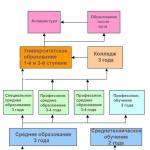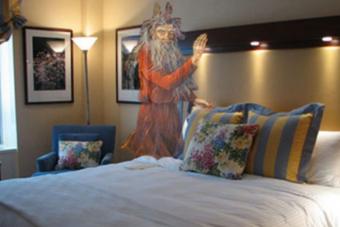Connective tissue is the most common in the body, accounting for more than half of a person's mass. By itself, it is not responsible for the work of body systems, but it has an auxiliary effect in all organs.
Features of the structure of connective tissue
There are three main types of connective tissue, which have a different structure and perform certain functions: connective tissue proper, cartilage and bone.
| Types of connective tissue | |
|---|---|
| Type of | Characteristic |
| dense fibrous | - Decorated, where chondrin fibers run in parallel; - unshaped, where the fibrous structures form a grid. |
| loose fibrous | Relative to cells, there is more intercellular substance, including collagen, elastic and reticular fibers. |
| Fabrics with special properties | - Reticular - forms the basis of hematopoietic organs, surrounding maturing cells; fatty - located in the abdominal region, on the hips, buttocks, storing energy resources; - pigmented - is in the iris of the eye, the skin of the nipples of the mammary glands; - mucous - one of the components of the umbilical cord. |
| Bone connective | Consists of osteoblasts, they are located inside the lacunae, between which blood vessels lie. The intercellular space is filled with mineral compounds and chondrin fibers. |
| cartilaginous connective | Strong, built from chondroblasts and chondroitin. Surrounded by the perichondrium, where new cells are formed. Allocate hyaline cartilage, elastic and fibrous. |
Connective tissue cell types
fibroblasts cells that produce an intermediate. They are engaged in the synthesis of fibrous formations and other components of the connective tissue. Thanks to them, wound healing and scar formation, encapsulation of foreign bodies. Still undifferentiated oval-shaped fibroblasts with a large number of ribosomes. Other organelles are poorly developed. Mature fibroblasts are large and have processes.
Fibrocytes is the final form of fibroblast development. They have a wing-shaped structure, the cytoplasm includes a limited number of organelles, and synthesis processes are reduced.
Myofibroblasts during differentiation they become fibroblasts. They are similar to myocytes, but unlike the latter, they have a developed EPS. These cells are often found in granulation tissue during wound healing.
macrophages- body size varies from 10 to 20 micrometers, oval shape. Among the organelles, the largest number of lysosomes. The plasmalemma forms long processes, thanks to which it captures foreign bodies. Macrophages serve to form innate and acquired immunity. Plasmocytes have an oval body, sometimes polygonal. The endoplasmic reticulum is developed and is responsible for the synthesis of antibodies.
Tissue basophils, or mast cells, are located in the wall of the digestive tract, uterus, mammary glands, tonsils. The shape of the body is different, sizes are from 20 to 35, sometimes reaching 100 microns. They are surrounded by a dense shell, inside they contain specific substances that are of great importance - heparin and histamine. Heparin prevents blood clotting, histamine acts on the capillary membrane and increases its permeability, which leads to the leakage of plasma through the walls of the bloodstream. As a result, blisters form under the epidermis. This phenomenon is often observed with anaphylaxis or allergies.
Adipocytes- cells that store lipids necessary for nutrition and energy processes. The fat cell is completely filled with fat, which stretches the cytoplasm into a thin ball, and the nucleus takes on a flattened shape.
melanocytes contain the pigment melanin, but they themselves do not produce it, but only capture the already synthesized by epithelial cells.
adventitial cells undifferentiated, can later transform into fibroblasts or adipocytes. They are found near capillaries, arteries, in the form of squamous cells.
The type of cells and the nucleus of the connective tissue differs in its subspecies. So an adipocyte in a transverse section looks like a ring with a signet, where the nucleus acts as a signet, and the ring is a thin cytoplasm. The plasma cell nucleus is small in size, located on the periphery of the cell, and the chromatin inside forms a characteristic pattern - a wheel with spokes.
Where is the connective tissue
Connective tissue has a variety of locations in the body. Thus, collagen fibrous structures form tendons, aponeuroses and fascial sheaths.
Unformed connective tissue is one of the components of dura mate (dura mater of the brain), bags of joints, heart valves. Elastic fibers that make up the vascular adventitia.
Brown adipose tissue is most developed in monthly children, provides effective thermoregulation. Cartilaginous tissue forms the nasal cartilage, laryngeal, external auditory canal. Bones form the internal skeleton. Blood is a liquid form of connective tissue that circulates through a closed circulatory system.
Connective tissue functions:
- support- forms the internal skeleton of a person, as well as the stroma of organs;
- nutritious- delivers O 2, lipids, amino acids, glucose with the blood stream;
- protective- is responsible for immune responses through the formation of antibodies;
- restorative- provides wound healing.
The difference between connective tissue and epithelial
- The epithelium covers the muscle tissue, the main component of the mucous membranes, forms the outer cover and provides a protective function. Connective tissue forms the parenchyma of organs, provides a supporting function, is responsible for the transport of nutrients, and plays an important role in metabolic processes.
- Non-cellular structures of the connective tissue are more developed.
- The appearance of the epithelium is similar to cells, and the cells of the connective tissue have an oblong shape.
- Different origin of tissues: the epithelium comes from the ectoderm and endoderm, and the connective tissue comes from the mesoderm.
Loose fibrous unformed connective tissue is the most common, located next to epithelial tissues, accompanies blood and lymphatic vessels in more or less quantity; is part of the skin and mucous membranes of organs. As layers of membranes containing an abundance of vessels, loose fibrous tissue is found in all tissues and organs (Fig. 30).
The intercellular substance is represented by two components: the main (amorphous) substance - a structureless matrix with a gelatinous consistency; fibers - collagen and elastic, located relatively loose and randomly, therefore the tissue is called unformed. Loose fibrous unformed connective tissue, due to the presence of intercellular substance, performs a support-trophic function, cells participate in immune reactions and regenerative processes in tissue damage. As part of the connective tissue, cells of various shapes are differentiated: adventitial, fibroblasts, fibrocytes, histiocytes, mast cells (tissue basophils), plasma cells and fat cells. adventitial(from lat. adventicus- alien, wandering) cells are the least differentiated, located along the outer surface of the capillaries, being cambial, actively dividing by mitosis and differentiating into fibroblasts, myofibroblasts and lipocytes. fibroblasts(from lat. fibrin- protein; blastos- sprout, overgrowth -
Rice. thirty
- 7 - macrophage; 2 - amorphous intercellular substance; 3 - plasma cell;
- 4 - fat cell; 5 - endothelium; 6 - adventitial cell; 7 - pericyte;
- 8 - endothelial cell; 9 - fibroblast; 10 - elastic fiber; 11 - mast cell; 12 - collagen fiber current) - protein producers, are permanent and most numerous cells. In mobile cell forms, the peripheral part of the cell contains contractile filaments, cells with a large number of contractile filaments - myofibroblasts - contribute to wound healing. Part of the fibroblasts is enclosed between densely spaced fibers, such cells are called fibrocytes, they lose the ability to divide, take an elongated shape and have strongly flattened nuclei. Macrophages (histiocytes) cells that have the ability to phagocytosis and accumulation of suspended colloidal substances in the cytoplasm are involved in general and local protective reactions of the immune system. The nucleus has well-defined contours. Possessing the ability to directed movement - chemotaxis, macrophages migrate to the focus of inflammation, where they become dominant cells. Macrophages are involved in the recognition, processing and presentation of antigen to lymphocytes. During inflammation, cells become irritated, increase in size, become mobile, and transform into structures called polyblasts. Macrophages cleanse the focus of foreign particles and destroyed cells, but also stimulate the functional activity of fibroblasts. Tissue basophils (labrocytes, mast cells) have an irregularly oval or rounded shape, numerous granules (grains) are located in the cytoplasm. The cells contain histamine, which dilates blood vessels, and secrete heparin, which prevents blood from clotting. Plasma cells (plasma cells) synthesize and secrete the bulk of immunoglobulins - antibodies (proteins formed in response to the action of an antigen). These cells are found in their own layer of the intestinal mucosa, the omentum, in the connective tissue between the lobules of the salivary, mammary glands, in the lymph nodes, and in the bone marrow. pigment cells have processes, in the cytoplasm there are many dark brown or black grains of pigment from the melanin group. The connective tissue of the skin of lower vertebrates - reptiles, amphibians, fish - contains a significant amount of pigment cells - chromatophores, which determine one or another color of the outer cover and perform a protective function. Pigment cells in mammals are concentrated mainly in the sclera, choroid and iris, and the ciliary body. Fat cells (lipocytes) are formed from adventitial cells of loose connective tissue, which are usually located in groups along blood vessels.
The drug "Loose fibrous unformed connective tissue of the subcutaneous tissue of the rat"(stained with hematoxylin). The drug is a small area of fixed subcutaneous tissue, stretched in the form of a thin film on a coverslip. At a low magnification (x10), the intercellular substance is revealed: a structureless amorphous matrix and two types of fibers - rather wide collagen fibers having a ribbon-like shape, and thin filamentous elastic fibers. With a high magnification of the microscope (x40), cells of various shapes differentiate in the connective tissue: adventitial cells - elongated cells with long processes; fibroblasts - have a spindle shape, since the central part is significantly thickened. The nucleus is large, weakly stained, one or two nucleoli are clearly visible. Ectoplasm is very light, endoplasm, on the contrary, is intensely stained due to the presence of a large amount of granular endoplasmic reticulum, which is due to the participation in the synthesis of high-molecular substances necessary both for building fibers and for the formation of an amorphous substance. Macrophages in the cytoplasm contain many vacuoles, which indicates an active participation in metabolism, the contours of the cytoplasm are clear, processes in the form of pseudopodia, so the cell is similar to an amoeba. Tissue basophils (labrocytes, mast cells) have an irregularly oval or round shape, sometimes with wide short processes; numerous basophilic granules (grains) are located in the cytoplasm. Plasmocytes (plasma cells) may be round or oval; the cytoplasm is sharply basophilic, with the exception of only a small rim of the cytoplasm near the nucleus - the perinuclear zone, along the periphery of the cytoplasm there are numerous small vacuoles.
The preparation "Adipose tissue of the omentum". The omentum is a film penetrated by blood vessels. When stained with Sudan III, accumulations of yellow rounded fat cells are visible. When stained with hematoxylin and eosin, the cricoid fat cells are not stained, the violet core is pushed to the periphery of the cytoplasm (Fig. 31).
In many parts of the animal body, significant accumulations of fat cells are formed, called adipose tissue. In connection with the peculiarities of the natural coloration, the specifics of the structure and function, as well as the location in mammals, there are two types of fat cells and, accordingly, two types of adipose tissue: white and brown.
White adipose tissue a significant amount is contained in the so-called fat depots: subcutaneous adipose tissue, especially developed in pigs, adipose tissue around the kidneys in the mesentery (perinephric tissue), in some breeds of sheep at the root of the tail (fat tail). The structural unit of white adipose tissue is spherical fat cells, up to 120 microns in diameter. With the development of cells, fatty

Rice. 31
a- total preparation of the omentum (Sudan III and hematoxylin); b- preparation of subcutaneous adipose tissue (hematoxylin and eosin): 7 - lipocyte; 2 - blood vessel;
3 - a piece of adipose tissue; 4 - fibers and cells of loose connective tissue
The values in the cytoplasm appear first in the form of small scattered drops, later merging into one large drop. The total amount of white adipose tissue in the body of animals of various species, breeds, sex, age, fatness ranges from 1 to 30% of live weight. Reserve fats are the most high-calorie substances, during the oxidation of which a large amount of energy is released in the body (1 g of fat \u003d 39 kJ). In cattle of meat and meat and dairy breeds, groups of fat cells are located in layers of loose fibrous connective tissue of skeletal muscles. The meat obtained from such animals has the best taste and is called "marble". Subcutaneous adipose tissue is of great importance for protecting the body from mechanical damage, from heat loss. Adipose tissue along the neurovascular bundles provides relative isolation, protection and limitation of mobility. Accumulations of fat cells combined with bundles of collagen fibers in the skin of the soles and paws create good cushioning properties. The role of adipose tissue as a depot of water is significant; the formation of water is an important feature of the metabolism of fats in animals living in arid regions (camels). During starvation, the body primarily uses spare fats from fat depot cells, in which fatty inclusions decrease and disappear. Adipose tissue of the eye orbit, epicardium, paws is preserved even with severe exhaustion. The color of adipose tissue depends on the type, breed and type of feeding of animals. Most animals, with the exception of pigs and goats, contain a pigment in their fat. carotene, giving yellow color to adipose tissue. In cattle, the adipose tissue of the pericardium contains many collagen fibers. kidney fat called the fatty tissue surrounding the ureters. In the back area, adipose tissue of pigs contains muscle tissue, as well as often hair follicles (bristle) and even hair bags. In the area of the peritoneum there is an accumulation of adipose tissue, the so-called mesenteric or mesenteric fat, which contains a large number of lymph nodes that accelerate oxidative processes and spoilage of fat. Blood vessels are often found in mesenteric fat, for example pigs have more arteries and cattle have more veins. Internal fat is a fatty tissue located under the peritoneum, contains a large number of fibers located in oblique and perpendicular directions. Sometimes pigment grains are found in the adipose tissue of pigs, in such cases brown or black spots are detected.
brown adipose tissue it is present in significant quantities in rodents and hibernating animals, as well as in newborn animals of other species. Location mainly under the skin between the shoulder blades, in the cervical region, mediastinum and along the aorta. Brown adipose tissue consists of relatively small cells that are very tightly adjacent to each other, resembling glandular tissue in appearance. Numerous nerve fibers approach the cells, braided with a dense network of blood capillaries. Brown adipose tissue cells are characterized by centrally located nuclei and the presence of small fat droplets in the cytoplasm, which do not merge into a larger drop. In the cytoplasm, between the fat drops, there are glycogen granules and numerous mitochondria, stained proteins of the transport electron system - cytochromes give the brown color to this tissue. In the cells of brown adipose tissue, oxidative processes are intense, accompanied by the release of a significant amount of energy. However, most of the generated energy is spent not on the synthesis of ATP molecules, but on heat generation. This property of brown tissue lipocytes is important for temperature regulation in newborn animals and for warming animals after waking up from hibernation.
test questions
- 1. Describe the embryonic connective tissue - mesenchyme.
- 2. What is the structure of mesenchymal cells?
- 3. Give a structural and functional characteristic of the cells of the reticular connective tissue.
- 4. What is the structure of reticular fibers and how can they be detected on histological preparations?
- 5. Describe the cells of loose fibrous connective tissue.
- 6. What is the structure of the intercellular substance?
- 7. What is the function of the structureless matrix - the main substance?
- 8. What is the structure and function of loose fibrous connective tissue fibers?
- 9. What dye can be used to detect fat inclusions?
A common feature for PVST is the predominance of the intercellular substance over the cellular component, and in the intercellular substance, the fibers predominate over the main amorphous substance and are very close (dense) to each other - all these structural features are reflected in the name of this tissue in a compressed form. PVST cells are overwhelmingly represented by fibroblasts and fibrocytes; macrophages, mast cells, plasma cells, poorly differentiated cells, etc.
The intercellular substance consists of densely arranged collagen fibers, the main substance is small.
PVST regenerates well due to mitosis of poorly specialized fibroblasts and their production of intercellular substance (collagen fibers) after differentiation into mature fibroblasts.
PVST function- ensuring mechanical strength.
Dense fibrous irregular connective tissue
Peculiarities: many fibers, few cells, fibers are randomly arranged
Localization: reticular layer of the dermis, periosteum, perichondrium, capsules of parenchymal organs.
CELLS
very few cells there are mainly fibroblasts, mast cells, macrophages can be found
INTERCELLULAR SUBSTANCE
FIBERS: collagen and elastic, many fibers
BASIC (AMORPHOUS) SUBSTANCE: glycosaminoglycans and proteoglycans in a small amount
Dense fibrous connective tissue
Peculiarities: many fibers, few cells, fibers have an ordered arrangement - they are collected in bundles
Localization: tendons, ligaments, capsules, fascia, fibrous membranes
CELLS
there are very few cells, mainly fibroblasts, mast cells, macrophages can be found
INTERCELLULAR SUBSTANCE
FIBERS: collagen and elastic; fibers - a lot; fibers have an ordered arrangement, form thick bundles
BASIC (AMORPHOUS) SUBSTANCE: glycosaminoglycans and proteoglycans in a very small amount
TENDON
Consists of thick, tightly lying parallel bundles of collagen fibers. They are surrounded by thin layers of loose fibrous unformed connective tissue; the thinnest - bundles of the 1st order, they are surrounded by endotenonium bundles of the 2nd order are surrounded by perithenonium, the tendon itself is a bundle of the 3rd order.
Connective tissues with special properties
Connective tissues with special properties (CTSS) include:
1. Reticular tissue.
2. Adipose tissue (white and brown fat).
3. Pigment fabric.
4. Mucous gelatinous tissue.
In embryogenesis, all connective tissues of the CTCC are formed from the mesenchyme. CTSS, like all tissues of the internal environment, consists of cells and intercellular substance, but the cellular component is represented, as a rule, by 1 population of cells.
1. Reticular tissue - forms the basis of hematopoietic organs, in a small amount there is around the blood vessels. Consists of reticular cells and intercellular substance, consisting of the ground substance and reticular fibers. Reticular cells - large process cells with oxyphilic cytoplasm, connecting with each other by processes form a looped network. Intertwining reticular fibers also form a network. Hence the name of the fabric - "reticular tissue" - mesh tissue. Reticular cells are capable of phagocytosis, produce constituent components of reticular fibers. Reticular tissue regenerates well due to the division of reticular cells and the production of intercellular substance by them.
Functions:
musculoskeletal (they are the supporting frame for maturing blood cells);
trophic (provide nutrition for maturing blood cells);
phagocytosis of dead cells, foreign particles and antigens;
create a specific microenvironment that determines the direction of differentiation of hematopoietic cells.
2. Adipose tissue is a collection of fat cells. In accordance with the presence of 2 types of fat cells, 2 types of adipose tissue are distinguished:
white fat(accumulation of white fat cells) - is present in the subcutaneous adipose tissue, in the omentums, around the parenchymal and hollow organs. Functions of white fat: supply of energy material and water; mechanical protection; participation in thermoregulation (thermal insulation).
brown fat(accumulation of brown fat cells) - found in hibernating animals, in humans only during the neonatal period and in early childhood. Functions of brown fat: participation in thermoregulation - fat will burn in the mitochondria of lipocytes, the heat released at the same time warms the blood in the nearby capillaries.
3. Pigment fabric - Accumulation of a large number of melanocytes. It is present in certain areas of the skin (around the nipples of the mammary glands), in the retina and iris of the eye, etc. Function: protection against excess light, UFL.
4. Mucous gelatinous tissue - available only in the embryo (under the skin, in the umbilical cord). There are very few cells (mucocytes) in this tissue, the intercellular substance predominates, and in it the gelatinous ground substance rich in hyaluronic acid. This structural feature determines the high turgor of this tissue. Function: mechanical protection of the underlying tissues, prevents clamping of the blood vessels of the umbilical cord.
Dense fibrous connective tissue is divided into unformed and formed.
Dense fibrous irregular connective tissue It is part of the papillary layer of the dermis, the outer shell of the aorta, is localized in the reticular layer of the dermis, periosteum, perichondrium.
Cells. There are significantly fewer cells than in loose connective tissue; there are mainly fibroblasts and fibrocytes, there are mast cells, macrophages.
intercellular substance consists of collagen and elastic randomly arranged fibers, as well as an amorphous component.
Dense fibrous connective tissue localized in tendons, ligaments, capsules, fascia, fibrous membranes. Its characteristic feature is the ordered arrangement of fibers, which are collected in bundles. There are few cells and amorphous component in it. A good example of densely formed connective tissue is the tendon.
The tendon consists of bundles of the 1st, 2nd, etc. orders. The bundles of the 1st order are represented by separate collagen fibers, between which fibrocytes are located. Several bundles of collagen fibers surrounded by thin layers of loose fibrous unformed connective tissue (endothenonium) form bundles of the 2nd order. The bundles of the 3rd order are surrounded by perithenonium.
The ligament is formed by bundles of elastic fibers.
Fibrocytes predominate among the cells, and the composition of the amorphous component is the same as in the dense unformed connective tissue.
Connective tissues with special properties
reticular tissue. This tissue forms the stroma (skeleton) of the organs of hematopoiesis and immune defense - red bone marrow, spleen, lymph nodes, lymphoid tissue associated with mucous membranes (tonsils, Peyer's patches, solitary follicles). The reticular cells in it are a type of fibroblasts, contain processes, with the help of which they are interconnected, forming a network (reticulum). They form a microenvironment for developing blood cells. In addition, there are also other types of cells characteristic of loose connective tissue (macrophages, mast cells, plasma cells, adipocytes) in a small amount.
The intercellular substance is represented by reticular fibers, which are impregnated with silver salts, therefore they are otherwise called argyrophilic fibers. The composition of the amorphous component is typical for loose connective tissue.
Adipose tissue subdivided into white and brown. Its main mass is made up of fat cells (adipocytes), between which there are small layers of loose fibrous unformed connective tissue with a characteristic structure for it.
White adipose tissue localized everywhere. In white adipose tissue, adipocytes contain one large drop of fat in the cytoplasm, and their nucleus and organelles are pushed to the periphery.
brown adipose tissue localized between the shoulder blades, near the kidneys, near the thyroid gland. Especially a lot of it in the fetus, and after birth, its amount is greatly reduced.
The cytoplasm of brown adipose tissue adipocytes contains many small fat droplets, the nucleus and organelles are located in the center of the cell, and there are many mitochondria. The brown color of the cells is due to the presence of a large number of iron-containing enzymes - cytochromes, which are involved in the oxidation of both fatty acids and glucose, but the resulting free energy is not stored in the form of ATP, but is dissipated in the form of heat; therefore, the function of brown adipose tissue is heat production and regulation of body temperature.
pigment fabric It is a normal loose or dense fibrous connective tissue containing a large number of pigment cells believed to originate from the neural crest. Localization: choroid of the eye, dermis in the area of the nipples of the mammary glands, birthmarks, nevi.
Mucous ( gelatinous ) Connective tissue It is found only in the composition of the umbilical cord (Wharton's jelly). Features: few cells and fibers, a lot of amorphous matter. Undifferentiated fibroblasts predominate among the cells. The intercellular substance contains a small amount of thin collagen fibers, the amorphous component is represented mainly by hyaluronic acid.
This type of connective tissue is found in all organs, as it accompanies the blood and lymphatic vessels and forms the stroma of many organs.
Morphofunctional characteristics of cellular elements and intercellular substance.
Structure. It consists of cells and intercellular substance (Fig. 6-1).
There are the followingcells loose fibrous connective tissue:
1. Fibroblasts- the most numerous group of cells, different in degree of differentiation, characterized primarily by the ability to synthesize fibrillar proteins (collagen, elastin) and glycosaminoglycans with their subsequent release into the intercellular substance. In the process of differentiation, a number of cells are formed:
stem cells;
semi-stem progenitor cells;
unspecialized fibroblasts- low-growth cells with a round or oval nucleus and a small nucleolus, basophilic cytoplasm rich in RNA.
Function: have a very low level of protein synthesis and secretion.
differentiated fibroblasts(mature) - large-sized cells (40-50 microns or more). Their nuclei are light, contain 1-2 large nucleoli. Cell borders are indistinct, blurred. The cytoplasm contains a well-developed granular endoplasmic reticulum.
Function: Intensive biosynthesis of RNA, collagen and elastic proteins, as well as glycosminoglycans and proteoglycans, necessary for the formation of the ground substance and fibers.
fibrocytes— definitive forms of fibroblast development. They have a spindle shape and pterygoid processes. They contain a small number of organelles, vacuoles, lipids and glycogen.
Function: the synthesis of collagen and other substances in these cells is sharply reduced.
- myofibroblasts- functionally similar to smooth muscle cells, but unlike the latter, they have a well-developed endoplasmic reticulum.
Function: these cells are observed in the granulation tissue of the wound process and in the uterus, during the development of pregnancy.
- fibroclasts.- cells with high phagocytic and hydrolytic activity, they contain a large number of lysosomes.
Function: take part in the resorption of the intercellular substance.
Rice. 6-1. Loose connective tissue. 1. Collagen fibers. 2. Elastic fibers. 3. Fibroblast. 4. Fibrocyte. 5. Macrophage. 6. Plasma cell. 7. Fat cell. 8. Tissue basophil (mast cell). 9. Pericyte. 10. Pigment cell. 11. Adventitial cage. 12. Basic substance. 13. Blood cells (leukocytes). 14. Reticular cell.
2. Macrophages wandering, actively phagocytic cells. The shape of macrophages is different: there are flattened, rounded, elongated and irregularly shaped cells. Their borders are always clearly defined, and the edges are uneven. . The cytolemma of macrophages forms deep folds and long microprotrusions, with the help of which these cells capture foreign particles. As a rule, they have one core. The cytoplasm is basophilic, rich in lysosomes, phagosomes and pinocytic vesicles, contains a moderate amount of mitochondria, granular endoplasmic reticulum, Golgi complex, inclusions of glycogen, lipids, etc.
Function: phagocytosis, biologically active factors and enzymes (interferon, lysozyme, pyrogens, proteases, acid hydrolases, etc.) are secreted into the intercellular substance, which ensures their various protective functions; produce monokine mediators, interleukin I, which activates DNA synthesis in lymphocytes; factors that activate the production of immunoglobulins, stimulating the differentiation of T- and B-lymphocytes, as well as cytolytic factors; provide processing and presentation of antigens.
3. Plasma cells (plasmocytes). Their size ranges from 7 to 10 microns. Cell shape is round or oval. The nuclei are relatively small, round or oval in shape, located eccentrically. The cytoplasm is sharply basophilic, contains a well-developed granular endoplasmic reticulum in which proteins (antibodies) are synthesized. Only a small light zone near the nucleus, forming the so-called sphere, or courtyard, is deprived of basophilia. Centrioles and the Golgi complex are found here.
Functions: These cells provide humoral immunity. They synthesize antibodies - gamma globulins (proteins) that are produced when an antigen appears in the body and neutralize it.
4. Tissue basophils (mast cells). Their cells have a varied shape, sometimes with short, wide processes, which is due to their ability to amoeboid movements. In the cytoplasm there is a specific granularity (blue), resembling granules of basophilic leukocytes. It contains heparin, hyaluronic acid, histamine and serotonin. Mast cell organelles are poorly developed.
Function: tissue basophils are regulators of local connective tissue homeostasis. In particular, heparin reduces the permeability of the intercellular substance, blood clotting, and has an anti-inflammatory effect. Histamine acts as its antagonist.
5. Adipocytes (fat cells) - located in groups, less often - one by one. Accumulating in large quantities, these cells form adipose tissue. The shape of solitary fat cells is spherical, they contain one large drop of neutral fat (triglycerides), which occupies the entire central part of the cell and is surrounded by a thin cytoplasmic rim, in the thickened part of which lies the nucleus. In this regard, adipocytes have a cricoid shape. In addition, in the cytoplasm of adipocytes there is a small amount of cholesterol, phospholipids, free fatty acids, etc.
Function: have the ability to accumulate large amounts of reserve fat, which is involved in trophism, energy production and water metabolism.
6. Pigment cells- have short, irregularly shaped processes. These cells contain the melanin pigment in their cytoplasm, which is capable of absorbing UV radiation.
Function: protection of cells from UV radiation.
7. Adventitial cells - unspecialized cells accompanying blood vessels. They have a flattened or fusiform shape with weakly basophilic cytoplasm, an oval nucleus, and underdeveloped organelles.
Function: acts as a cambium.
8. Pericytes have a process shape and surround the blood capillaries in the form of a basket, located in the crevices of their basement membrane.
Function: regulate changes in the lumen of blood capillaries.
9. Leukocytes migrate to the connective tissue from the blood.
Function: see blood cells.
intercellular substance comprises the main substance and the fibers located in them - collagen, elastic and reticular.
To  collagen fibers in loose, unformed fibrous connective tissue, they are located in different directions in the form of twisted rounded or flattened strands 1-3 microns thick or more. Their length is indefinite. The internal structure of the collagen fiber is determined by the fibrillar protein - collagen, which is synthesized in the ribosomes of the granular endoplasmic reticulum of fibroblasts. In the structure of these fibers, several levels of organization are distinguished (Fig. 6-2):
collagen fibers in loose, unformed fibrous connective tissue, they are located in different directions in the form of twisted rounded or flattened strands 1-3 microns thick or more. Their length is indefinite. The internal structure of the collagen fiber is determined by the fibrillar protein - collagen, which is synthesized in the ribosomes of the granular endoplasmic reticulum of fibroblasts. In the structure of these fibers, several levels of organization are distinguished (Fig. 6-2):
— The first one is the molecular level — represented by collagen protein molecules, having a length of about 280 nm and a width of 1.4 nm. They are built from triplets - three polypeptide chains of the collagen precursor - procollagen, twisted into a single helix. Each procollagen chain contains sets of three different amino acids, repeatedly and regularly repeated throughout its length. The first amino acid in such a set can be any, the second is proline or lysine, the third is glycine.
Rice. 6-2. Levels of structural organization of collagen fibers (scheme).
A. I. Polypeptide chain.
II. Molecules of collagen (tropocollagen).
III. Protofibrils (microfibrils).
IV. Fibril of minimum thickness, in which transverse striation becomes visible.
V. Collagen fiber.
B. Spiral structure of a collagen macromolecule (according to Rich); small light circles - glycine, large light circles - proline, shaded circles - hydroxyproline. (According to Yu. I. Afanasiev, N. A. Yurina).
- The second - supramolecular, extracellular level - represents collagen molecules connected in length and cross-linked by means of hydrogen bonds. First formed protoftsbrills, and 5-b protofibrils, fastened together by side bonds, make up microfibrils, about 10 nm thick. They are distinguishable in an electron microscope in the form of slightly sinuous threads.
— The third, fibrillar level. With the participation of glycosaminoglycans and glycoproteins, microfibrils form fibril bundles. They are transversely striated structures with an average thickness of 50–100 nm. The repetition period of dark and light areas is 64 nm.
— Fourth, fiber level. Depending on the topography, the composition of the collagen fiber (thickness 1-10 microns) includes from several fibrils to several tens .
Function: determine the strength of connective tissues.
Elastic fibers - their shape is rounded or flattened, widely anastomose with each other. The thickness of elastic fibers is usually less than collagen. The main chemical component of elastic fibers is a globular protein elastin, synthesized by fibroblasts. Electron microscopy made it possible to establish that the elastic fibers in the center contain amorphous component, and on the periphery microfibrillar. In terms of strength, elastic fibers are inferior to collagen ones.
Function: determines the elasticity and extensibility of the connective tissue.
Reticular fibers belong to the type of collagen fibers, but differ in smaller thickness, branching and anastomoses. They contain an increased amount of carbohydrates, which are synthesized by reticular cells and lipids. Resistant to acids and alkalis. They form a three-dimensional network (reticulum), from which they take their name.
Base substance is a gelatinous hydrophilic medium, in the formation of which fibroblasts play an important role. It consists of sulfated (chondroitinsulfuric acid, keratin sulfate, etc.) and non-sulfated (hyaluronic acid) glycosaminoglycans, which determine the consistency and functional features of the main substance. In addition to these components, the composition of the main substance includes lipids, albumins and blood globulins, minerals (salts of sodium, potassium, calcium, etc.).
Function: transport of metabolites between cells and blood; mechanical (binding of cells and fibers, cell adhesion, etc.); support; protective; water metabolism; regulation of ionic composition.





